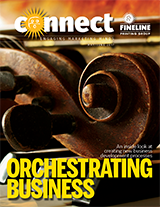Compelling Content Is A Must For Marketing

Look out for Connect Magazine to hit your doorsteps soon. If you’re not receiving our beautiful bimonthly publication packed with articles devoted to marketing, marketing services and strategic concepts for marketers – subscribe here today!
Marketing is a house of cards without compelling content
by Charles Lunan
“Lack of true content is killing the reputation of content marketing. That’s the view of Joe Pulizzi, who is hearing more griping from the small business owners and executives attending his content marketing classes. They complain that their email newsletters, blogs and Facebook pages are not getting enough traction. When the complaints came up at a workshop a few months ago, an exasperated Pulizzi asked his audience how their content was different. He was greeted with silence.”
With a little prodding, one vendor said it had posted coupons on Facebook, another vendor had shared content with 300 of its dealers, and a third posted an article that was intentionally generic to avoid giving away his advice. He told them that until they became serious about creating original, compelling content, they’d be better off spending their money on advertising.
It’s hard to find a bigger content marketing evangelist than Pulizzi, who founded the Content Marketing Institute (CMI) in the late 2000s after deciding he could help global brands do a much better job with their marketing. Today, CMI offers content marketing education and training, produces the Content Marketing World Conference and Expo, publishes CCO [Chief Content Officer] magazine and offers its Content Marketing Master Class through a nationwide seminar series. Pulizzi has written two books on the topic and CMI’s site is chock full of great content about content marketing, which it describes as “a strategic marketing approach focused on creating and distributing valuable, relevant, and consistent content to attract and retain a clearly defined audience – and, ultimately, to drive profitable customer action.”
When done correctly, Pulizzi argues content marketing establishes an aura of authority and trust that are at the core of any brand promise and can help brands own their media channels, rather than rent them through advertising. In his 2015 book, “Content Inc.,” Pulizzi argues that finding and filling information voids online can help startup companies stake out leadership positions in fast-moving markets before they even ship their first product. The problem is that “99 percent” of marketers are not generating distinctive content.
“Somewhere along the line,” Pulizzi wrote in a blog post earlier this year, “we marketers became infatuated with the tools and less concerned about what we put inside them. This, my friends, has got to change.”
Many marketers have found telling real people’s stories to be one of the most potent tools for breaking through what Rutgers University Marketing Professor Mark Schaefer called “overwhelming information density. In his book, “The Content Code,” such stories are original and, therefore, authentic by definition.
 The way marketers create and distribute content is constantly changing, but the basic dynamics of storytelling – and their power to influence – have stood the test of time. “People still love a good yarn and, more importantly, they will remember it long after their memory of product specifications, endorsements and Facebook promotions fade,” Schaefer says.
The way marketers create and distribute content is constantly changing, but the basic dynamics of storytelling – and their power to influence – have stood the test of time. “People still love a good yarn and, more importantly, they will remember it long after their memory of product specifications, endorsements and Facebook promotions fade,” Schaefer says.
In helping small active lifestyle brands craft their voices, Verde Brand Communications CEO Kristin Carpenter-Ogden has found it particularly useful to start with the founder. Their stories nearly always follow one of the seven classic heroic themes marketers have exploited for centuries, such as overcoming giants, naysayers and scarcity.
Even gear heads rarely remember the weight of every waterproof-breathable garment they use, what blend of fabrics it features or what awards it has won, but they can nearly always recall the story about the sudden mountain storm that inspired the founder to create the brand.
The challenge for the marketer remains finding stories that will evoke the desired response from the target customer in a way that is consistent or enhances a client’s existing brand. “The objective of storytelling is to earn trust,” says Carpenter-Ogden, whose firm works with dozens of small active lifestyle brands, including K2, Keen, Mad River Canoe, Pearl Izumi and Raleigh. “People buy products they think align with the people they want to be.”
Seeing this, and under pressure from Greenpeace, United Students Against Sweatshops and other activist groups, a handful of forward-thinking athletic and apparel brands began incorporating corporate responsibility into their content marketing strategies in the 2000s.
Nike, Adidas, Patagonia and Timberland began publishing annual reports laying out progress they had made against sustainability goals, such as reducing their greenhouse gas emissions, and use of energy and water to position themselves as leaders with their environmentally-minded consumers amid growing pressure from activists. Though fast fashion apparel brands and retailers, including Wal-Mart Stores, have since launched their own corporate sustainability programs, it’s unlikely they will gain significant mindshare with environmentally-minded consumers, even though their efforts will have a bigger impact due to their larger size.
 Athletic and outdoor brands own the space and they continue to raise the bar. In its annual corporate sustainability report, outdoor gear retailer REI (Recreational Equipment Inc.) now lists information still considered trade secrets by some brands, including a list of all its overseas factories by name and location, aggregate results of factory audits, and the percentage of factories they’ve placed on probation for failing to meet REI’s environmental and labor standards. Such transparency is fast becoming the new coin of the realm in a world where more and more middle and upper-class consumers expect to know not only where their products are made, but how the workers who made them are treated, what the brand is doing to lessen their carbon footprint and even what they are doing to bring manufacturing jobs back to the United States.
Athletic and outdoor brands own the space and they continue to raise the bar. In its annual corporate sustainability report, outdoor gear retailer REI (Recreational Equipment Inc.) now lists information still considered trade secrets by some brands, including a list of all its overseas factories by name and location, aggregate results of factory audits, and the percentage of factories they’ve placed on probation for failing to meet REI’s environmental and labor standards. Such transparency is fast becoming the new coin of the realm in a world where more and more middle and upper-class consumers expect to know not only where their products are made, but how the workers who made them are treated, what the brand is doing to lessen their carbon footprint and even what they are doing to bring manufacturing jobs back to the United States.
Staking out a leadership position on sustainability also has created a steady stream of content, including stories about Timberland’s work reforesting Haiti and Grand Trunk’s efforts to begin sourcing some of its hammocks in the United States. Founded in 2002 by two surfing buddies to import hammocks they discovered while surfing in Thailand, Grand Trunk beat a much larger competitor to begin making nylon sling hammocks in the United States.
It took the small company several years to piece together a U.S. supply chain capable of delivering hammocks that meet its quality standards and price points. The OneMade line ultimately will have to compete on quality and price. In the meantime, however, the venture has distinguished Grand Trunk in a rapidly growing, but increasingly crowded market. Skillful storytelling, which should generate some compelling content, sure beats adding to the torrent of “me-too” content that is softening the content marketing world.
Want more?
Subscribe to Connect today.
Coming soon to your mailboxes and doorsteps!


